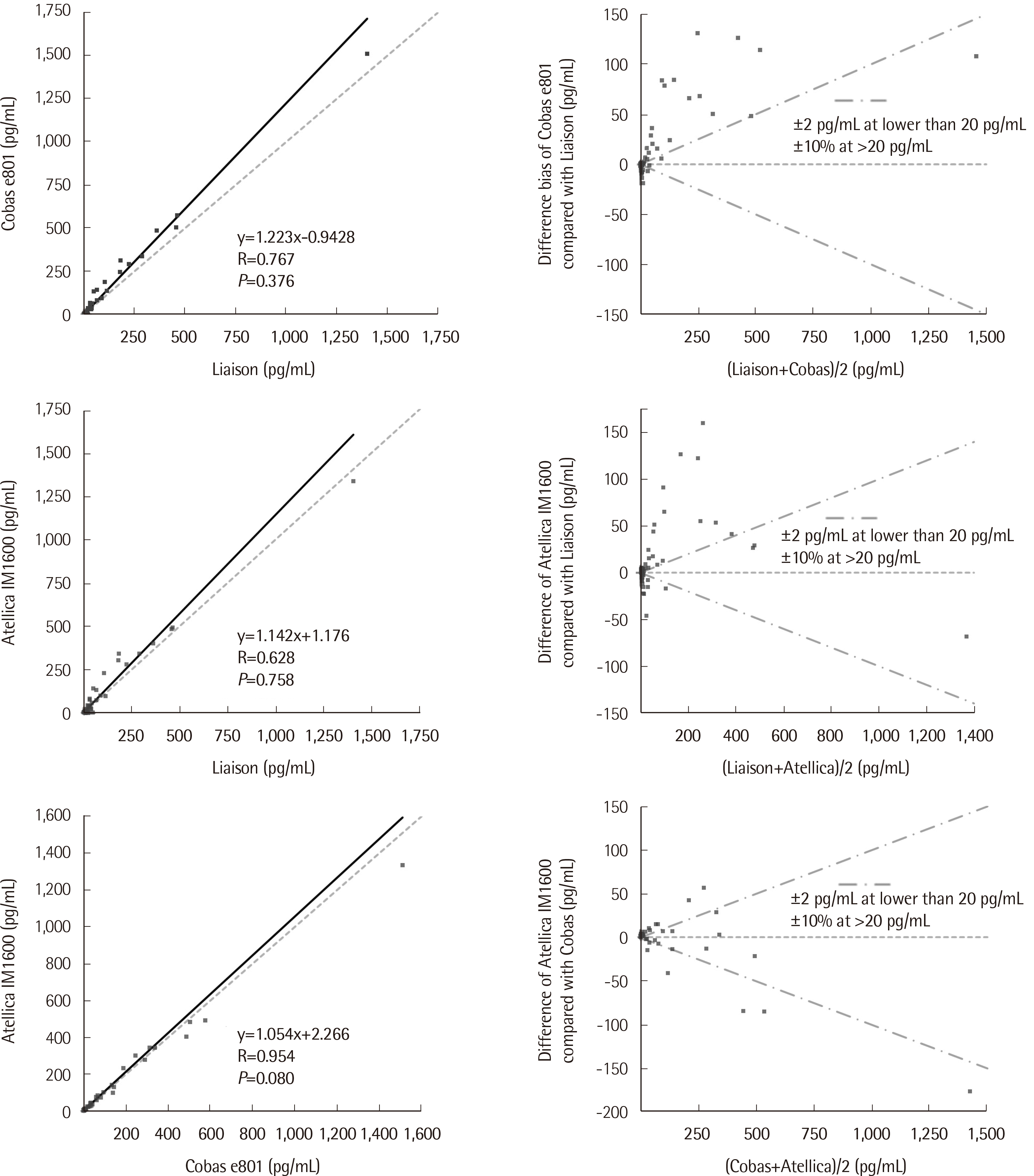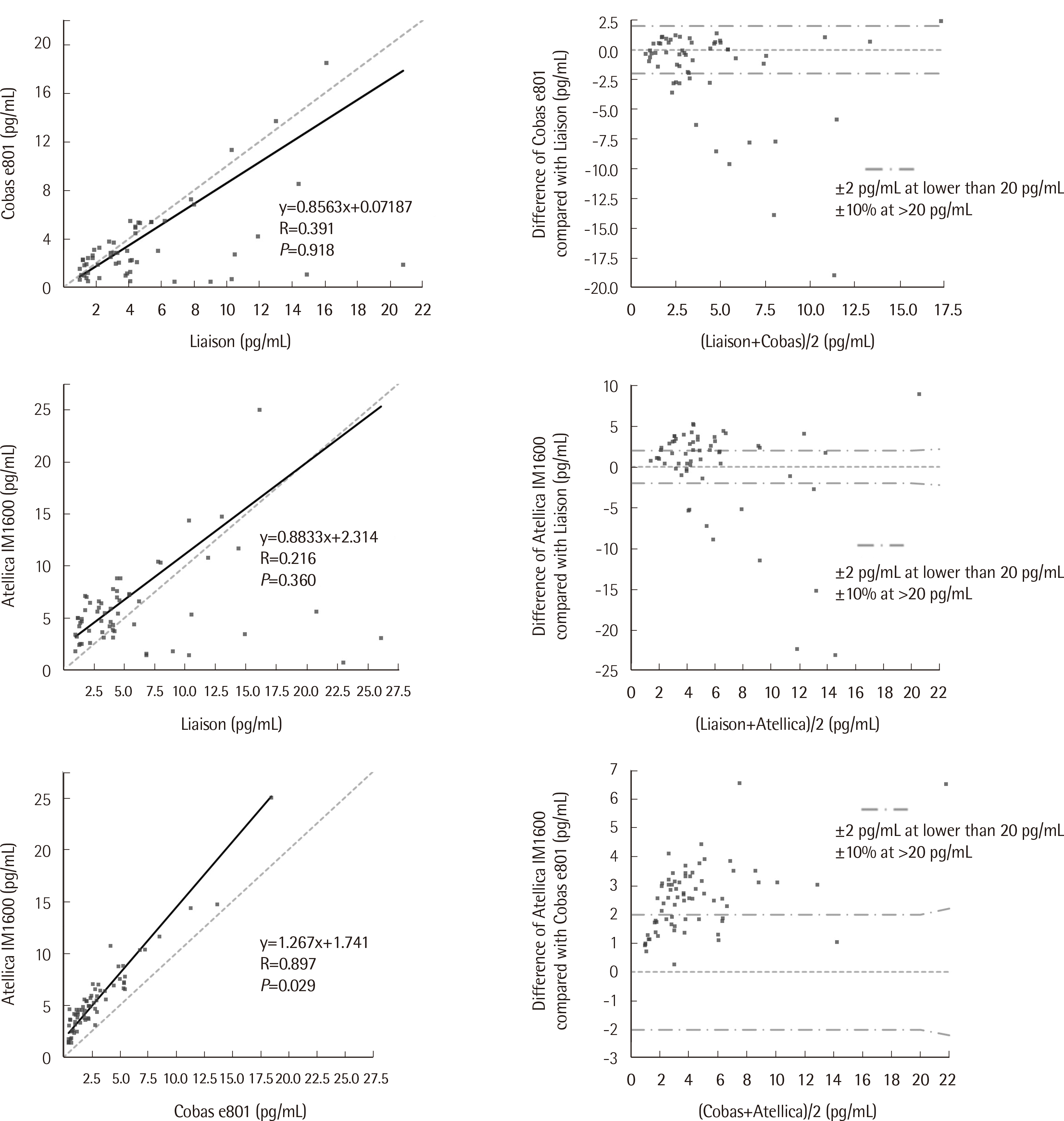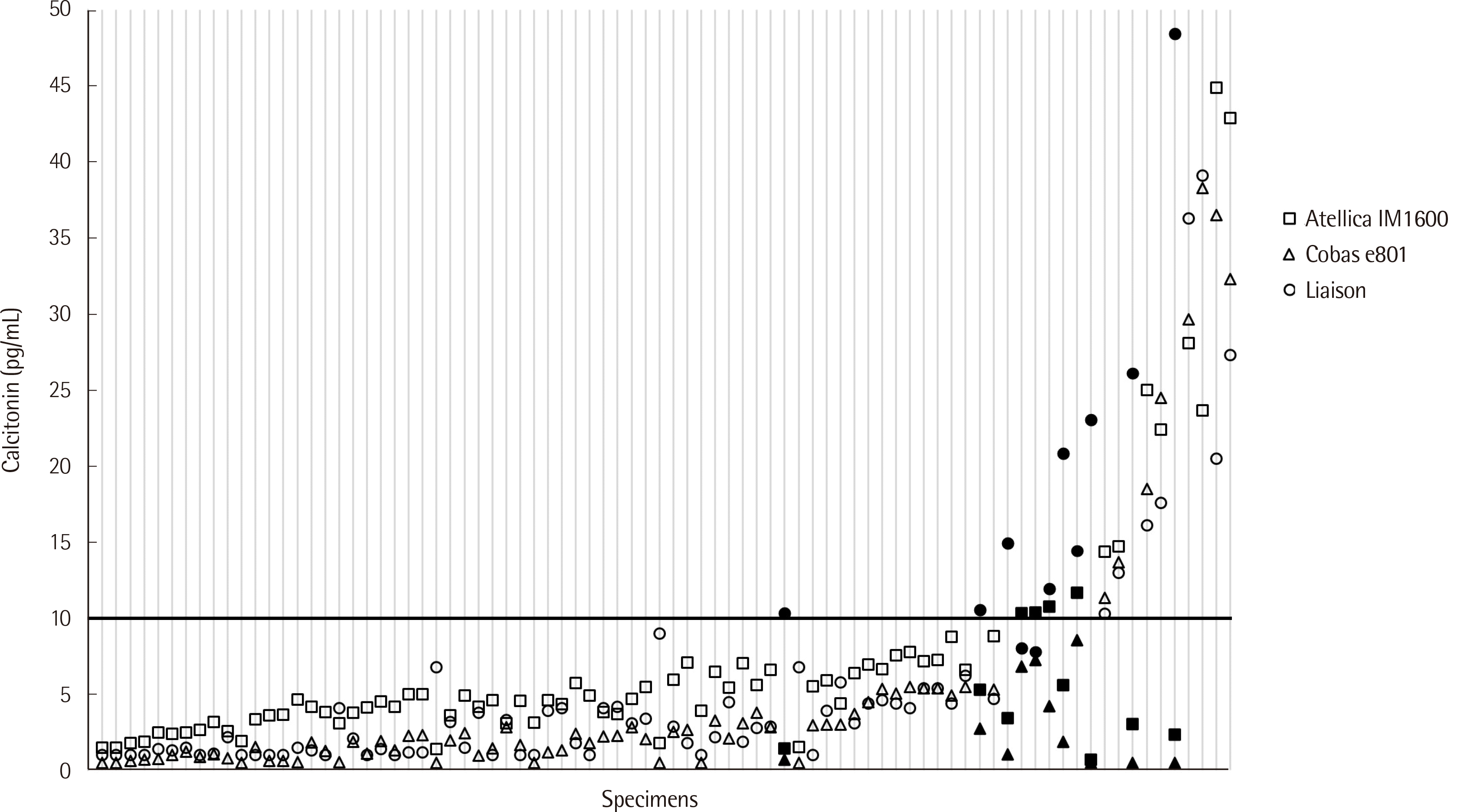1. Copp DH, Cameron EC, Cheney BA, Davidson AG, Henze KG. 1962; Evidence for calcitonin--a new hormone from the parathyroid that lowers blood calcium. Endocrinology. 70:638–49. DOI:
10.1210/endo-70-5-638. PMID:
13881211.

2. Hirsch PF, Voelkel EF, Munson PL. 1964; Thyrocalcitonin: hypocalcemic hypophosphatemic principle of the thyroid gland. Science. 146:412–3. DOI:
10.1126/science.146.3642.412. PMID:
14186470.

4. Machens A, Hoffmann F, Sekulla C, Dralle H. 2009; Importance of gender-specific calcitonin thresholds in screening for occult sporadic medullary thyroid cancer. Endocr Relat Cancer. 16:1291–8. DOI:
10.1677/ERC-09-0136. PMID:
19726541.

5. Cavalier E, Carlisi A, Bekaert AC, Rousselle O, Chapelle JP, Delanaye P. 2011; Analytical validation of the Liaison Calcitonin_II-Gen (DiaSorin). Clin Chem Lab Med. 49:271–5. DOI:
10.1515/CCLM.2011.036. PMID:
21083442.

6. Guilloteau D, Perdrisot R, Calmettes C, Baulieu JL, Lecomte P, Kaphan G, et al. 1990; Diagnosis of medullary carcinoma of the thyroid (MCT) by calcitonin assay using monoclonal antibodies: criteria for the pentagastrin stimulation test in hereditary MCT. J Clin Endocrinol Metab. 71:1064–7. DOI:
10.1210/jcem-71-4-1064. PMID:
2401708.

7. Tobler PH, Tschopp FA, Dambacher MA, Born W, Fischer JA. 1983; Identification and characterization of calcitonin forms in plasma and urine of normal subjects and medullary carcinoma patients. J Clin Endocrinol Metab. 57:749–54. DOI:
10.1210/jcem-57-4-749. PMID:
6885964.

8. Cheung K, Roman SA, Wang TS, Walker HD, Sosa JA. 2008; Calcitonin measurement in the evaluation of thyroid nodules in the United States: a cost-effectiveness and decision analysis. J Clin Endocrinol Metab. 93:2173–80. DOI:
10.1210/jc.2007-2496. PMID:
18364376.

9. Kahaly GJ, Algeciras-Schimnich A, Davis TE, Diana T, Feldkamp J, Karger S, et al. 2017; United States and European multicenter prospective study for the analytical performance and clinical validation of a novel sensitive fully automated immunoassay for calcitonin. Clin Chem. 63:1489–96. DOI:
10.1373/clinchem.2016.270009. PMID:
28687633.

10. Allelein S, Ehlers M, Morneau C, Schwartz K, Goretzki PE, Seppel T, et al. 2018; Measurement of basal serum calcitonin for the diagnosis of medullary thyroid cancer. Horm Metab Res. 50:23–8. DOI:
10.1055/s-0043-122237. PMID:
29169190.

11. Rink T, Truong PN, Schroth HJ, Diener J, Zimny M, Grünwald F. 2009; Calculation and validation of a plasma calcitonin limit for early detection of medullary thyroid carcinoma in nodular thyroid disease. Thyroid. 19:327–32. DOI:
10.1089/thy.2008.0102. PMID:
19355822.

12. Engelbach M, Gorges R, Forst T, Pfutzner A, Dawood R, Heerdt S, et al. 2000; Improved diagnostic methods in the follow-up of medullary thyroid carcinoma by highly specific calcitonin measurements. J Clin Endocrinol Metab. 85:1890–4. DOI:
10.1210/jcem.85.5.6601. PMID:
10843170.

13. Wion-Barbot N, Schuffenecker I, Niccoli P, Conte-Devolx B, Lecomte P, Houdent C, et al. 1997; Results of the calcitonin stimulation test in normal volunteers compared with genetically unaffected members of MEN 2A and familial medullary thyroid carcinoma families. Ann Endocrinol (Paris). 58:302–8. PMID:
9436479.
14. Conte-Devolx B, Schuffenecker I, Niccoli P, Maes B, Boneu A, Barbot N, et al. 1997; Multiple endocrine neoplasia type 2: management of patients and subjects at risk. French Study Group on Calcitonin-Secreting Tumors (GETC). Horm Res. 47:221–6. DOI:
10.1159/000185467. PMID:
9167955.
15. Vierhapper H, Niederle B, Bieglmayer C, Kaserer K, Baumgartner-Parzer S. 2005; Early diagnosis and curative therapy of medullary thyroid carcinoma by routine measurement of serum calcitonin in patients with thyroid disorders. Thyroid. 15:1267–72. DOI:
10.1089/thy.2005.15.1267. PMID:
16356091.

16. Karges W, Dralle H, Raue F, Mann K, Reiners C, Grussendorf M, et al. 2004; Calcitonin measurement to detect medullary thyroid carcinoma in nodular goiter: German evidence-based consensus recommendation. Exp Clin Endocrinol Diabetes. 112:52–8. DOI:
10.1055/s-2004-815727. PMID:
14758572.

17. Elisei R, Bottici V, Luchetti F, Di Coscio G, Romei C, Grasso L, et al. 2004; Impact of routine measurement of serum calcitonin on the diagnosis and outcome of medullary thyroid cancer: experience in 10,864 patients with nodular thyroid disorders. J Clin Endocrinol Metab. 89:163–8. DOI:
10.1210/jc.2003-030550. PMID:
14715844.

18. Ozgen AG, Hamulu F, Bayraktar F, Yilmaz C, Tuzun M, Yetkin E, et al. 1999; Evaluation of routine basal serum calcitonin measurement for early diagnosis of medullary thyroid carcinoma in seven hundred seventy-three patients with nodular goiter. Thyroid. 9:579–82. DOI:
10.1089/thy.1999.9.579. PMID:
10411120.

19. Cavalier E, Carlisi A, Chapelle JP, Delanaye P. 2008; Analytical quality of calcitonin determination and its effect on the adequacy of screening for medullary carcinoma of the thyroid. Clin Chem. 54:929–30. DOI:
10.1373/clinchem.2007.100636. PMID:
18443183.

20. Schiettecatte J, Strasser O, Anckaert E, Smitz J. 2016; Performance evaluation of an automated electrochemiluminescent calcitonin (CT) immunoassay in diagnosis of medullary thyroid carcinoma. Clin Biochem. 49:929–31. DOI:
10.1016/j.clinbiochem.2016.05.006. PMID:
27182955.

21. Motté P, Vauzelle P, Gardet P, Ghillani P, Caillou B, Parmentier C, et al. 1988; Construction and clinical validation of a sensitive and specific assay for serum mature calcitonin using monoclonal anti-peptide antibodies. Clin Chim Acta. 174:35–54. DOI:
10.1016/0009-8981(88)90365-8. PMID:
2454766.

22. Leclerc L, Vantyghem MC, Fourrier F, Proye C, Wemeau JL. d'Herbomez M. 2001; Clinical evaluation of a new sensitive calcitonin assay: study of specificity. Clin Chim Acta. 311:149–55. DOI:
10.1016/S0009-8981(01)00582-4. PMID:
11566174.
23. Bieglmayer C, Vierhapper H, Dudczak R, Niederle B. 2007; Measurement of calcitonin by immunoassay analyzers. Clin Chem Lab Med. 45:662–6. DOI:
10.1515/CCLM.2007.124. PMID:
17484631.

24. Clinical and Laboratory Standards Institute. 2018. Measurement procedure comparison and bias estimation using patient samples; Approved guideline-Third edition. EP09c-ED3. Clinical and Laboratory Standards Institute;EP09c-ED3. Wayne, PA:
25. McPherson RA, Pincus MR, editors. 2017. Henry's clinical diagnosis and management by laboratory methods. 23rd ed. Elsevier;St. Louis, MO:
27. National Institute for Biological Standards and Control. WHO International Standard, Calcitonin, Human, NIBSC code: 89/620, Instructions for use, (Version 5.0, Dated 28/03/2013).
https://www.nibsc.org/documents/ifu/89-620.pdf. Last accessed on Feb 2021.
28. Herrmann BL, Schmid KW, Goerges R, Kemen M, Mann K. 2010; Calcitonin screening and pentagastrin testing: predictive value for the diagnosis of medullary carcinoma in nodular thyroid disease. Eur J Endocrinol. 162:1141–5. DOI:
10.1530/EJE-10-0111. PMID:
20332126.

29. Ramachandran R, Benfield P, Dhillo WS, White S, Chapman R, Meeran K, et al. 2009; Need for revision of diagnostic limits for medullary thyroid carcinoma with a new immunochemiluminometric calcitonin assay. Clin Chem. 55:2225–6. DOI:
10.1373/clinchem.2009.129361. PMID:
19833839.








 PDF
PDF Citation
Citation Print
Print



 XML Download
XML Download